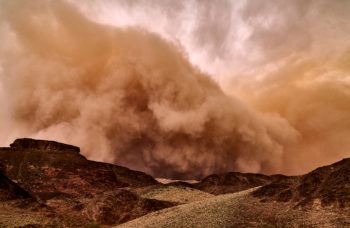Sandstorms Can Be Big Problems

Q: You hear a lot about sandstorms lately. What causes sandstorms?
A. Sandstorms are caused by strong winds that occur in desert or semi-arid regions, and they carry thick clouds of dust and sand, often reducing visibility to near zero in many cases, says John Nielsen-Gammon of Texas A&M University. In many parts of the world, such as the deserts of the Southwest U.S. or in Africa or the Middle East, sandstorms can create havoc with man and machine. “A sandstorm can last for several hours to a full day,” says Nielsen-Gammon. “Most of the time, sandstorms affect only the air from about 1-3 miles high, so airplanes flying above that range are okay. But on the ground, sand moving at about 50 miles an hour can be a real nightmare. It can clog up just about anything that is mechanical, from a soldier’s rifle to a car or an army tank. Once the sandstorm has passed, a thorough cleaning of just about anything is required.”
Q: What types of sandstorms can occur?
A: There are two types of sandstorms, says Nielsen-Gammon. “The first kind is the result of a severe thunderstorm that creates strong winds. This kind is called a ‘haboob,’ which is an Arabic word for blowing dust. The second type is the one most Americans are familiar with. It’s caused by a curving of the jet stream which brings strong winds to the surface. Sandstorms tend to be worse during the daytime because the ground is heated up by the sun and the dust can be carried greater distances. That’s why breathing can become a real problem, and some type of mask is often required. Probably the worst sandstorms occur in China and Mongolia. The sand blows so hard that there is a ‘yellow rain’ effect. So much sand is in the air that it changes the color of raindrops, and there appears to be a yellow rain falling from the sky.”
This article originally appeared on the Texas A&M Department of Atmospheric Sciences website.





